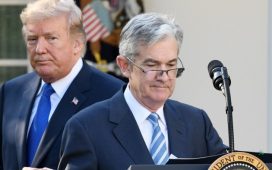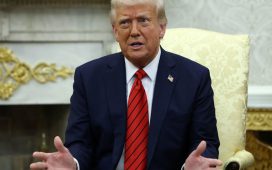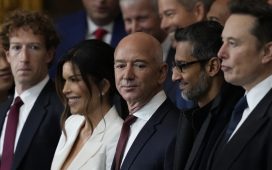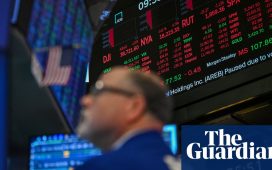Good morning. McDonald’s has played an outsized role in this year’s US election: Kamala Harris and Tim Walz boast about having worked there to polish their working-class bona fides, and Donald Trump went to a Pennsylvania franchise to flip burgers on Sunday. Yesterday, McDonald’s shares fell nearly 6 per cent in after-hours trading, when an E. coli outbreak was linked to its food. A metaphor for the state of US politics? Email us: robert.armstrong@ft.com and aiden.reiter@ft.com.
The term premium & bond vigilantes
The Treasury term premium is rising again, and it has the market’s attention. For those who slept through the relevant bit of bond class — who can blame you — the term premium is the yield provided by a single long-term bond in excess of the expected yield on a series of short-term bonds; paradigmatically, the difference between the 10-year Treasury yield and 10 consecutive one-year bonds.
This time around, there is a clear consensus on what the higher-term premium signals: investor worries about the sustainability of the US fiscal situation.
Apollo’s Torsten Slok says that the “term premium [reflects] the willingness of investors to lend money to the US government over the next 10 years. If that goes up (as it is doing at the moment) then it tells us that investors are getting more worried about fiscal sustainability.” Calvin Tse of BNP Paribas says that the “causal driver [of the higher premium] is people selling 10s, because people are worried about the fiscal situation”. Tse puts this down specifically to the rising expectations of a Republican sweep in next month’s US election, which he believes would create much wider deficits than a Harris victory and divided government.
The rising term premium, in other words, is the work of the “bond vigilantes”, a ruthless gang that once kept the government honest, but is widely thought to have retired.
This interpretation makes sense as far as it goes, but oversimplifies a complex and opaque situation. Here is a chart of the two standard-term premium estimates, each acronyms for the economists who built them. The ACM model is built on yield data alone; KW layers on yield forecasts.

The first and totally obvious point to make here is that while the term premium is rising, it is not hugely out of its recent reading range, and remains very low by historical standards (the average going back to 1990 is over 1.1 per cent on the ACM model, and 0.8 per cent on the KW model). The idea that the term premium is a measure of fiscal sustainability, and that it is waving an especially red flag at the moment, needs to be kept in perspective.
The second and more slippery point is that a rising term premium can mean a number of different things. A year ago, when the premium was last rising sharply, Unhedged wrote a series of pieces about this, noting, among other things, that:
-
The term premium can result from a mismatch between supply and demand of long-term bonds. Fiscal vigilantism (is that a word?) is only one possible reason for such a mismatch. Among the others are changes in demand from commercial and central banks, or from international investors — in Japan, say — responding to local financial conditions.
-
A breakdown in the negative correlation between stock and bond returns can drive the term premium up, too. When bonds don’t hedge stocks, investors want to be paid more for owning them. And this tends to happen when inflation is high and central banks have to raise rates (see: the horrible year 2022). So if investors are more worried about inflation because the economic data is coming in hot, and think there is a chance the Federal Reserve may have to reverse course and tighten policy again, it is natural that the term premium should rise. That is exactly what is happening now.
-
Certainly, it makes sense that term premiums should rise when everyone knows the secular bull market in bonds is over. No one expects much in the way of capital gains on long bonds now. They want yield.
We’ll wait for a more decisive move in the term premium before we celebrate the return of the bond vigilantes.
Saying ‘fire the CEO’ without saying ‘fire the CEO’
A few days ago Unhedged wrote about the activist investor Starboard Value’s quixotic tilt at Pfizer. Pfizer has problems, for sure, but they are very pharma-industry problems. The company is not growing and has no new drugs that promise to get revenue moving anytime soon. The only real solution to this kind of problem is developing or buying drugs that really work. This depends on strong clinical trial results, which can’t just be willed or spent into existence. Time and luck is required.
All of this is miles from the sort of things activists are best at: improving capital allocation, separating non-core businesses, eliminating unprofitable product lines, and so on. Sure, Pfizer could have bought different companies or bet on different molecules, but that’s water under the bridge, and there is no sense shouting, “next time, get the drugs that make a lot of money!” If drug development strategy needs a reboot, that is a project that will bear fruit many years after the activist investor is out the door.
One thing Starboard could do, we suggested, is call for the CEO, Albert Bourla, to be sacked. This is an immediate action that would signal the company’s commitment to doing the slow, hard turnaround-type things that need doing. It could, in other words, move the stock within an activist investor’s timeframe.
Yesterday Starboard revealed their Pfizer investment case in detail at a conference (the slide deck is here). The presentation did not call for Bourla to be sacked, but it came extremely close. Drug development productivity had been terrible in recent years, it pointed out, and Bourla himself told investors early in his tenure that he should be judged on exactly this basis. So, the presentation concluded: “The board needs to actively hold management accountable for earning appropriate returns on R&D and M&A moving forward.” That sounds like code for “fire Bourla” to us. Only the “moving forward” tagged on at the end leaves a sliver of room for an another interpretation.
The interesting question, strategically, is why the Starboard team decided to use code at all. They may be calculating that a change of management will impress the market more if the board is the first to broach it explicitly. They may be right about this. In addition, they may be calculating that being explicit might harden the board’s resolve. Again, this sounds right. But there is no real doubt about what Starboard’s strategy is.
Pfizer’s shares were unmoved yesterday. Expect Starboard to drop the code before long.
One good read
FT Unhedged podcast

Can’t get enough of Unhedged? Listen to our new podcast, for a 15-minute dive into the latest markets news and financial headlines, twice a week. Catch up on past editions of the newsletter here.






